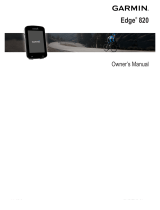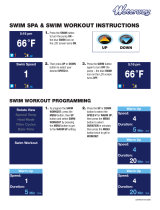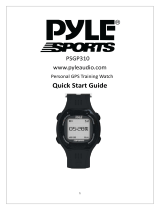
Heart Rate Variability and Stress Level............................... 16
Viewing Your Heart Rate Variability and Stress Level.... 17
Performance Condition........................................................ 17
Viewing Your Performance Condition............................. 17
Lactate Threshold................................................................ 17
Performing a Guided Test to Determine Your Lactate
Threshold........................................................................ 17
Getting Your FTP Estimate.................................................. 17
Conducting an FTP Test................................................. 17
Training Status..........................................................................18
Training Status Levels......................................................... 18
Tips for Getting Your Training Status.............................. 18
Heat and Altitude Performance Acclimation........................ 18
Training Load....................................................................... 19
Training Load Focus............................................................ 19
Recovery Time..................................................................... 19
Viewing Your Recovery Time.......................................... 19
Recovery Heart Rate.......................................................19
Body Battery™..........................................................................19
Viewing the Body Battery Widget.........................................19
Tips for Improved Body Battery Data................................... 19
Pulse Oximeter............................................................. 20
Getting Pulse Oximeter Readings............................................ 20
Turning On All-Day Pulse Oximeter Readings......................... 20
Turning Off Automatic Pulse Oximeter Readings..................... 20
Turning On Pulse Oximeter Sleep Tracking............................. 20
Tips for Erratic Pulse Oximeter Data........................................ 20
Training......................................................................... 20
Setting Up Your User Profile.....................................................20
Fitness Goals....................................................................... 20
About Heart Rate Zones...................................................... 21
Setting Your Heart Rate Zones....................................... 21
Letting the Device Set Your Heart Rate Zones............... 21
Heart Rate Zone Calculations......................................... 21
Setting Your Power Zones................................................... 21
Activity Tracking........................................................................21
Auto Goal............................................................................. 21
Using the Move Alert............................................................22
Sleep Tracking..................................................................... 22
Using Automated Sleep Tracking....................................22
Using Do Not Disturb Mode............................................ 22
Intensity Minutes.................................................................. 22
Earning Intensity Minutes................................................ 22
Garmin Move IQ™............................................................... 22
Activity Tracking Settings..................................................... 22
Turning Off Activity Tracking........................................... 22
Workouts...................................................................................22
Following a Workout From Garmin Connect........................ 22
Creating a Custom Workout on Garmin Connect................ 22
Sending a Custom Workout to Your Device................... 23
Starting a Workout............................................................... 23
Following a Daily Suggested Workout................................. 23
Turning Daily Suggested Workout Prompts On and
Off................................................................................... 23
Following a Pool Swim Workout.......................................... 23
Recording a Critical Swim Speed Test............................23
Editing Your Critical Swim Speed Result........................ 23
About the Training Calendar................................................ 23
Using Garmin Connect Training Plans............................ 23
Adaptive Training Plans.................................................. 23
Interval Workouts...................................................................... 24
Creating an Interval Workout............................................... 24
Starting an Interval Workout................................................ 24
Stopping an Interval Workout...............................................24
PacePro Training...................................................................... 24
Downloading a PacePro Plan from Garmin Connect........... 24
Starting a PacePro Plan
.......................................................24
Stopping a PacePro Plan................................................ 24
Creating a PacePro Plan on Your Watch............................ 24
Segments..................................................................................25
Strava™ Segments.............................................................. 25
Viewing Segment Details..................................................... 25
Racing a Segment............................................................... 25
Setting a Segment to Adjust Automatically.......................... 25
Using Virtual Partner®.............................................................. 25
Setting a Training Target.......................................................... 25
Cancelling a Training Target................................................ 25
Racing a Previous Activity........................................................ 25
Personal Records..................................................................... 26
Viewing Your Personal Records.......................................... 26
Restoring a Personal Record............................................... 26
Clearing a Personal Record................................................. 26
Clearing All Personal Records............................................. 26
Pausing Your Training Status................................................... 26
Resuming Your Paused Training Status.............................. 26
Clocks............................................................................ 26
Setting an Alarm....................................................................... 26
Editing an Alarm...................................................................26
Starting the Countdown Timer.................................................. 26
Deleting a Timer...................................................................27
Using the Stopwatch................................................................. 27
Adding Alternate Time Zones................................................... 27
Editing an Alternate Time Zone........................................... 27
Navigation..................................................................... 27
Saving Your Location............................................................... 27
Editing Your Saved Locations.............................................. 27
Projecting a Waypoint............................................................... 27
Navigating to a Destination....................................................... 27
Courses.................................................................................... 27
Creating and Following a Course on Your Device............... 27
Creating a Course on Garmin Connect............................... 28
Sending a Course to Your Device................................... 28
Viewing or Editing Course Details........................................28
Using ClimbPro......................................................................... 28
Marking and Starting Navigation to a Man Overboard
Location.................................................................................... 28
Navigating with Sight 'N Go...................................................... 28
Navigating to Your Starting Point During an Activity................ 28
Navigating to the Starting Point of a Saved Activity................. 28
Stopping Navigation................................................................. 29
Map........................................................................................... 29
Panning and Zooming the Map............................................ 29
Compass...................................................................................29
Altimeter and Barometer........................................................... 29
History........................................................................... 29
Using History............................................................................ 29
Multisport History................................................................. 29
Viewing Your Time in Each Heart Rate Zone...................... 29
Viewing Data Totals.................................................................. 29
Using the Odometer..................................................................29
Deleting History........................................................................ 30
Customizing Your Device............................................ 30
Activities and App Settings....................................................... 30
Customizing the Data Screens............................................ 31
Adding a Map to an Activity................................................. 31
Alerts.................................................................................... 31
Setting an Alert................................................................31
Auto Lap...............................................................................31
Marking Laps by Distance............................................... 31
Enabling Auto Pause®......................................................... 32
Enabling Auto Climb............................................................ 32
ii Table of Contents






















